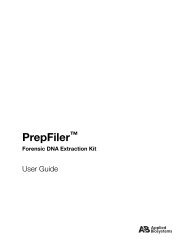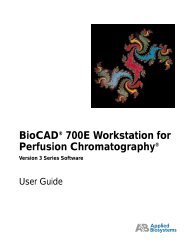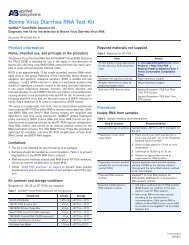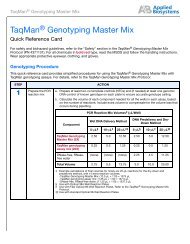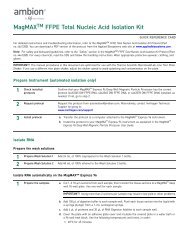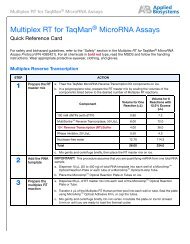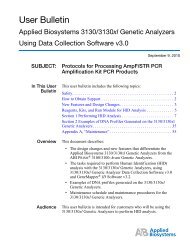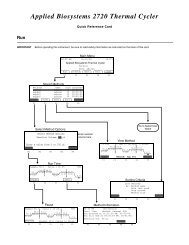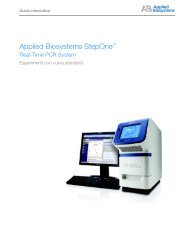AmpliTaq and AmpliTaq Gold DNA Polymerase - Applied Biosystems
AmpliTaq and AmpliTaq Gold DNA Polymerase - Applied Biosystems
AmpliTaq and AmpliTaq Gold DNA Polymerase - Applied Biosystems
You also want an ePaper? Increase the reach of your titles
YUMPU automatically turns print PDFs into web optimized ePapers that Google loves.
histopathology. The mucosal immune response was characterized by morphometric analysis oflymphoid follicles <strong>and</strong> by differentiating lymphocyte populations with antibodies against surfacemarkers. Infecting H. pylori strains were positive for vacAs1 but lacked cagPAI <strong>and</strong> an active oipAgene. Colonization density was uniform throughout the stomach. Upregulation of IFN-{gamma},IL-1{alpha}, IL-1{beta}, <strong>and</strong> IL-8 <strong>and</strong> increased severity of inflammatory infiltrates <strong>and</strong> fibrosiswere observed in infected cats. The median number <strong>and</strong> total area of lymphoid aggregates were5 <strong>and</strong> 10 times greater, respectively, in the stomachs of infected than uninfected cats. Secondarylymphoid follicles in uninfected cats were rare <strong>and</strong> positive for BLA.36 <strong>and</strong> B220 but negative forCD3 <strong>and</strong> CD79{alpha}, whereas in infected cats they were frequent <strong>and</strong> positive for BLA.36,CD79{alpha}, <strong>and</strong> CD3 but negative for B220. Upregulation of IFN-{gamma}, IL-1{alpha}, IL-1{beta}, <strong>and</strong> IL-8 <strong>and</strong> marked hyperplasia of secondary lymphoid follicles are early consequencesof H. pylori infection in cats. The response appears to be similar to that of infected people,particularly children, can develop independently of the pathogenicity factors cagPAI <strong>and</strong> oipA,<strong>and</strong> is not correlated with the degree of colonization density or urease activity.Flieger, A., K. Rydzewski, et al. (2004). "Cloning <strong>and</strong> Characterization of the Gene Encoding the MajorCell-Associated Phospholipase A of Legionella pneumophila, plaB, Exhibiting Hemolytic Activity."Infect. Immun. 72(5): 2648-2658.http://iai.asm.org/cgi/content/abstract/72/5/2648Legionella pneumophila, the causative agent of Legionnaires' disease, is an intracellularpathogen of amoebae, macrophages, <strong>and</strong> epithelial cells. The pathology of Legionella infectionsinvolves alveolar cell destruction, <strong>and</strong> several proteins of L. pneumophila are known to contributeto this ability. By screening a genomic library of L. pneumophila, we found an additional L.pneumophila gene, plaB, which coded for a hemolytic activity <strong>and</strong> contained a lipase consensusmotif in its deduced protein sequence. Moreover, Escherichia coli harboring the L. pneumophilaplaB gene showed increased activity in releasing fatty acids predominantly from diacylphospho<strong>and</strong>lysophospholipids, demonstrating that it encodes a phospholipase A. It has been reportedthat culture supernatants <strong>and</strong> cell lysates of L. pneumophila possess phospholipase A activity;however, only the major secreted lysophospholipase A PlaA has been investigated on themolecular level. We therefore generated isogenic L. pneumophila plaB mutants <strong>and</strong> tested thosefor hemolysis, lipolytic activities, <strong>and</strong> intracellular survival in amoebae <strong>and</strong> macrophages.Compared to wild-type L. pneumophila, the plaB mutant showed reduced hemolysis of human redblood cells <strong>and</strong> almost completely lost its cell-associated lipolytic activity. We conclude that L.pneumophila plaB is the gene encoding the major cell-associated phospholipase A, possiblycontributing to bacterial cytotoxicity due to its hemolytic activity. On the other h<strong>and</strong>, in view of thefact that the plaB mutant multiplied like the wild type both in U937 macrophages <strong>and</strong> inAcanthamoeba castellanii amoebae, plaB is not essential for intracellular survival of thepathogen.John, M., I. T. Kudva, et al. (2005). "Use of In Vivo-Induced Antigen Technology for Identification ofEscherichia coli O157:H7 Proteins Expressed during Human Infection." Infect. Immun. 73(5):2665-2679.http://iai.asm.org/cgi/content/abstract/73/5/2665Using in vivo-induced antigen technology (IVIAT), a modified immunoscreening technique thatcircumvents the need for animal models, we directly identified immunogenic Escherichia coliO157:H7 (O157) proteins expressed either specifically during human infection but not duringgrowth under st<strong>and</strong>ard laboratory conditions or at significantly higher levels in vivo than in vitro.IVIAT identified 223 O157 proteins expressed during human infection, several of which were



